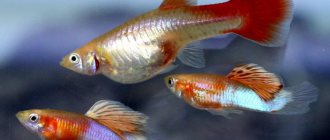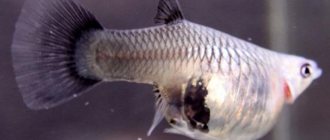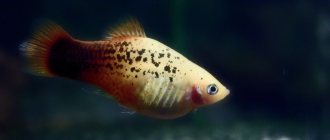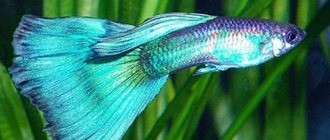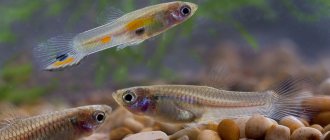Guppy, one of the most popular aquarium fish, does not produce eggs, but live fry. From the first days, guppy fry are able to swim and feed independently. Once born in a community aquarium, the fry rarely survive. Defenseless babies easily become prey for adult fish, which is why aquarists prefer to breed guppies in special aquariums. How to organize the right conditions for the offspring, what to feed and when to transplant into a large tank - there are many questions. Let's talk in more detail about the nuances of keeping and caring for tiny jellyfish.
Preparing conditions for a pregnant female
Pregnancy in guppies lasts from 25 to 30 days. Before birth - approximately 2-3 days before the birth of the fry, the fish must be transferred from the general aquarium to the fish tank.
Reasons for relocating pregnant females:
- fry can become prey to adult fish;
- the fish needs to adapt to the new environment a few days before giving birth - if you transplant the female immediately before giving birth, she will be stressed, and the offspring will be weak and unviable.
How to understand that it is time to transplant the female into the nursery:
- the stomach becomes large and square;
- the dark spot at the anal fin increases in size.
Requirements for the aquarium in which the female spends several days before giving birth and in which the fry are born:
- volume - 20-40 l;
- water - clean and settled water is mixed with aquarium water in a ratio of 2:3;
- temperature - from +24...+26°С;
- equipment - lamp, filter and compressor for aeration;
- other conditions - a small amount of soil, algae with long stems.
About a day before the birth of the offspring, the female slows down - she moves little and practically does not eat. She tries to stay close to devices that emit heat.
Requirements for offspring survival
First of all, in order for the offspring to survive in full, the female must be placed in a separate container in advance. At the same time, the container should contain plants among which the fry will find shelter. After giving birth, the female is immediately removed, as she may well begin to eat her offspring.
IMPORTANT! If the female has not been removed from the community aquarium, then in order to preserve the offspring, all the fry must be caught and placed separately. You can use a plastic glass for catching.
Terms of content
The fry have been hatched, and we need to take care of the care and maintenance of the fry so that they develop well. To do this, they are given certain conditions:
- The fish tank where the fish are born should have an average volume of 30 liters. This will help the babies develop well and make the process of caring for them easier;
- It will be easier to care for young fish if there is no soil, stones or plants in the container;
- A daily water change of 35% of the total amount of water is required. In this case, the water is left to stand for 3 days;
- A compressor, filter and heater must be placed in the container if reproduction occurs in winter. The optimal water temperature is considered to be 25 degrees Celsius.
It must be remembered that you must care for a female guppy who is about to spawn fry according to all the rules. Because if you add too warm water, she will begin to give birth prematurely, and some of the fry will die, as they will be underdeveloped.
IMPORTANT! It is necessary to provide all these conditions so that the fry grow healthy and there are no problems during their development.
How to save fry?
To prevent young animals from becoming victims of large fish, it is recommended to equip the aquarium with all kinds of shelters, and most importantly, plant more plants.
The best algae for an aquarium with guppy fry:
- superficial - duckweed, salvinia and floating riccia;
- floating in the water are pinnate and leafy elodea.
A distinctive feature of guppies is their thin, easily damaged skin. Plants with hard leaves should not be planted; driftwood shells with pointed edges are also contraindicated for fry.
Plant food
The diet of guppy fry, as well as adult fish, must include plant foods . Green algae. They usually grow in the aquarium itself, making up phytoplankton. Also in every aquarium there is zooplankton, represented by the smallest living organisms. They will become food for the fry from the very first days of their life.
Birth of fry
A unique feature of guppies, pleasant for aquarists and facilitating breeding and selection, is the ability to give birth several times, having been fertilized once.
The duration of labor is from 1 to 24 hours. It is extremely difficult to understand exactly when the process will end. After giving birth, the female and the fry are left for a day. If there are plants in the nursery, then livestock losses will be minimal.
Number
The number of fry born is determined by the physiological characteristics of the female, her age and size, the number of births and variety. If birth occurs in a community aquarium, it is difficult to count the fry.
On average, one female gives birth to from 15 to 60 fry at a time. There is a danger that the fish will eat part of its offspring. Such situations happen rarely and are usually associated with stress.
Appearance
Guppies are viviparous fish, so newly born fry can independently eat food and swim, dodging large neighbors in the aquarium.
Appearance Features:
- length - from 2 to 4 mm;
- color - absent, bodies transparent;
- eyes are large and black.
Height
The rate of growth and development of guppy fry largely depends on the conditions of detention. The quality of the water and the volume of the aquarium are especially important. Lighting and diet also affect the growth rate of guppies.
How do guppies grow?
- in the first week, the fry practically double in length, growing to 5-7 mm;
- after the second week, the length of the fry increases to 20 mm;
- Guppies fully grow in 4-5 months.
An adult female reaches a length of 50-60 mm, males - 20-40 mm.
How to distinguish males from females?
The first sexual characteristics of guppies can be seen only two weeks after birth. The fry are sorted as they grow. Already at the age of one month, some individuals can give birth to offspring. Thanks to sorting, it is possible to prevent early and unwanted pregnancies.
Males and females are seated in different containers. To separate the fry, it is important to learn how to distinguish them by sex. In the container where the grown fry are placed, it is necessary to add water from the aquarium in which they lived before moving.
Gender differences:
- males are slimmer and at two weeks of age their bright colors begin to appear;
- in females the abdomen protrudes more strongly, and near the anal fin there is a small dark spot;
- in males, the lower fin is elongated and curled, located near the anus.
The lower fin of male guppies gradually turns into a gonopodium, then aquarists do not have problems with gender recognition.
By seating males and females in different aquariums, it is possible to achieve two benefits at once - it is good for the health of the younger generation, and it simplifies care.
Sex differences
Approximately 14-15 days after birth, the fry begin to develop sexual differences.
In male fish, the anal fin, the gonopodium, begins to form. It is located on the abdomen and resembles a small tube in shape, performing the function of a genital organ. Then there is a gradual coloration in bright colors and the growth of a lush tail and dorsal fin.
During this period, females develop a dark spot near the anus; in this place, the fry will be located in the future during pregnancy. The abdomen is also rounded. The color of females does not change much; light shades of yellow, blue and others may appear.
It is important to separate males from females, as earlier fertilization is possible, which negatively affects the health of the fish and future offspring.
Grown-up male fry can be introduced into a common aquarium at the age of 1 month, and females can be released at 4-5 months. Their size should be 2.5-3 cm.
Care in the first days
In the first 2-3 days of life, guppies require special attention. Caring for fish is simple, but their health depends on it.
Features of newborn care:
- Water. In order for the fry to feel good and not get sick, the water in the aquarium must be updated daily. Approximately 30% of the total volume needs to be replaced. Add clean water that has been standing for 2-3 days.
- Temperature. During the first two weeks of life, it is maintained at +28°C, after a week it is lowered to +26°C, and after another week - to +24°C.
- Lighting. In the first 6 days, the lamps are not turned off, and then the backlight is turned on for 12 hours a day.
- Feed. In the first days, the fry are fed 4 to 5 times a day. They give a small amount of food. The main thing is that the fry are well-fed all the time, and their bellies are round. They give a variety of food, but in crushed form so that the kids can swallow it. For the first 5 days, the fry are given “live dust”, microworms, phytoplankton and dry food. The guppy's diet may also contain Artemia larvae and boiled egg yolks.
Food that the fry did not eat during feeding must be removed from the aquarium each time. The food should not float on top of the water all the time.
Types of food
The fry need to be fed often and quite a lot. Some aquarists do not turn off the lighting in the aquarium where the fry are located for several days and organize dosed feeding every 3-4 hours.
There are two main approaches to the issue of food choice.
- Some guppy owners successfully raise their pets using natural food (protein and plant foods).
- But there are also adherents of branded starter feeds.
It is difficult to say unequivocally which method is better, but it is important that the diet is balanced. Without overfeeding, of course.
Over 2 weeks of age
Grown-up guppies acquire coloring; it is still defective, but it already allows one to distinguish brighter and more beautiful males from females.
After two weeks and up to two months of age, the fry are cared for according to a new scheme:
- Feeding. Instead of 4-5 times, the fry are fed only 2 times a day. You need to give enough food so that the fish eat it. Residues must be collected from the surface, otherwise the aquarium will quickly become dirty. Young guppies are fed every day, but once a week they have a fasting day to cleanse the fish’s digestive system.
- Illumination. The backlight duration is reduced from 12 hours to 8-10 hours a day.
- Temperature. It can be lowered to +18°C. This is usually done in winter to prevent fertilization.
All this time, the growing guppies live in a separate aquarium; they are introduced to large fish only after they have grown to 2.5-3 cm. Next, the breeding process is kept under control - the most attractive and bright males are selected and, placing them with females, they get guppies that have inherited the beauty of their parents.
The growth of fish stops at three months of age. But after this period, the males begin to show intense coloration. The guppy's coloring becomes bright and juicy, and the fins not only become colored, but become lush.
Females, unlike males, practically do not change color, but only increase in size. Their scales acquire only a certain shade - yellowish, blue, olive. Young guppies, under favorable conditions, breed monthly.
Home Recipes
A good protein food can be prepared from ordinary products. Let's look at several recipes for hearty and balanced homemade food for fry.
Boiled egg
Boil a chicken egg, remove the yolk and crumble it with a fork. Then dilute with a small amount of aquarium water and drop it into the vessel with the fry from a pipette. You can put the yolk in a piece of gauze, lower it into the container with the guppy and stir it so that egg dust sprinkles - this will become food for the young. Keep in mind that such complementary foods quickly spoil the water. If you use it, change the water more often than usual.
Curdled milk
Pour boiling water over it. The casein (protein) will coagulate and form a curd. Catch it with a net with small holes and rinse it well to remove the whey. Feed the fish from a net by shaking it over the water. The smallest particles of food will fall onto the surface of the water. Unlike yolk, curdled milk does not pollute the aquarium environment as actively.
Powdered milk
Pour fresh into a plate and place it on a container of boiling water. Stirring regularly, evaporate the liquid. The resulting powder can not dissolve in water for hours, during which time it is completely eaten by the fry. When buying ready-made powdered milk in a store, pay attention to the composition, which should not contain anything unnecessary!
Omelette
Beat 2 eggs into the pan, add 2 tsp. nettle or oatmeal and, stirring continuously, pour in 100 ml of boiling milk. When the egg has curled, remove it from the heat and cool. Chop before serving to the fry.
Cheese
Take natural hard cheese, grate it on the finest grater and dry it if necessary. Add it to the water a little at a time, as it quickly spoils it.
Food prepared at home can only be given to fry as a supplement to the diet . It cannot become a complete food for them, since it does not provide them with all the required nutrients.
Newborn guppies must receive phytoplankton, algae and other components of plant origin. It is important to feed them with chopped live food.
How and what to feed guppy fry?
Guppy fry, just born, already have a mouth with which they can eat food. True, it is very small, so they cannot eat anything other than crushed food. The fry do not know how to chew food; they only swallow food that fits into their mouth.
For feeding the fry, food that is finely ground, literally to the point of dust, is suitable. The feeding schedule and norms should be observed. Overeating, like starvation, is detrimental to guppy health.
Feeding mode
The frequency of feeding depends on the age of the fry and as the fish grow older they are fed less and less. To make caring for growing fish easier, the aquarist needs to have a feeding schedule that takes into account age, and strictly adhere to it.
Feeding regimen for guppy fry:
- the first 7 days - once every 4 hours;
- 2nd and 3rd week - once every 6 hours;
- after the third week - every 8 hours.
Natural food
The best food for guppy fry is what they eat in the wild. Or at least close to it. It is recommended to give them as much live food as possible, since the consumption of protein foods activates the growth of fish.
What to give baby guppies:
- worms;
- larvae;
- protozoa.
Ciliates and other microorganisms are called “live dust” among aquarists. Their dimensions are 0.15-0.25 mm. This food is suitable for the youngest fry.
Every aquarist can grow food for fry at home.
How to prepare food for fry:
- Pour some of the water from the aquarium into a glass jar and place it close to the window.
- After 3-4 days, the water will “bloom” - small algae or phytoplankton will appear.
- Fill up the food with a syringe and release it into a container where small guppies grow.
Grown-up guppies are fed with nauplii and artemia larvae. They are high-calorie foods and are given out little by little - like a delicacy. Overfeeding with larvae threatens the fish with obesity. In addition to larvae, guppies love nematodes and microworms.
From one month onwards, bloodworms, tubifex worms and other larvae are added to the natural food given to young guppies.
Store-bought feed
Not all aquarists are ready to grow live food. This is not only a troublesome, but also an unpleasant task. Industrial feed helps to get out of the situation.
There are special ready-made foods for guppies, among which the following brands are especially popular:
- JBL is a food created specifically for viviparous fish.
- Tetra biomin is a paste food that is easy to use. The tube of paste is dipped into water and the required portion is squeezed out.
- Tetra mikromin is a powdered food that contains all the elements necessary for guppy fry. These feeds are treated with UV radiation for the purpose of disinfection.
How to replace live food?
Nothing is assimilated by the guppy’s digestive system as live food, and it is impossible to completely replace it with industrial food alone. If it is not possible to give the fish worms, larvae and other protein “delicacies”, they are replaced with ordinary animal products.
What can you feed guppy fry, instead of larvae and other live food:
- Yolks. Boil the egg hard, peel and remove the yolk. Grind it by diluting it in aquarium water. Place the ground mass into a piece of gauze, tie it in a knot and squeeze the mass into the aquarium. Please note that such food can quickly deteriorate and pollute the water.
- Powdered milk. The fry love it very much and instantly eat it. This product has high nutritional value, but it is often not recommended to give it to fish.
- Curdled milk. Guppies happily eat lumps of fermented milk product, which decomposes rather slowly in water. The product is first poured with boiling water so that the casein curdles like cottage cheese. The lump is thrown into a sieve and the liquid is drained. The remaining mass is wrapped in gauze and immersed in the aquarium.
You can find out how to make food for fry yourself in the video:
Choosing the right food
Since we're talking about nutrition, it's worth talking about it in more detail. After all, it also affects how long guppy fry grow. In the first days, it is recommended to use the yolk of a boiled egg, crushed and dissolved in water. It is small enough that tiny fry, a few centimeters long, can have a hearty meal.
As soon as they grow up, the diet needs to be varied. If you use only dry food (daphnia, gammarus, or even specialized food with vitamin supplements), then the rate of development will decrease. In addition, females in the future will produce fewer fry and will become sick more often. Try to provide them with better food - Artemia nauplii, bred at home, or chopped bloodworms, tubifex.
If you feed exclusively dry food, then the guppies will reach their maximum size only by 6-8 months, and among them there will be many sick and simply dull individuals. With adequate live nutrition, already at 4 months, guppies look like real beauties and beauties - fit, bright, healthy and active.
Launch into a community aquarium
The addition of grown-up fry to a common aquarium containing adult guppies, and perhaps other fish compatible with this species, is carried out as they reach a certain size. The main condition for launching is that the fry must grow enough so that their neighbors do not eat them.
The age of the fry is secondary. Some fry already at two weeks of age reach a size at which they cannot be swallowed by an adult fish, while others hardly grow during this time. Small guppies, the undersized ones, should not be allowed into the general aquarium - they will simply be eaten there.
Conditions for launching fry into a community aquarium:
- their body length is 15 mm;
- in the aquarium - plants and other shelters;
- neighbors - absence of aggressive and predatory fish.
They prepare in advance for moving the fry to a common aquarium - they gradually reduce the temperature of the water in the fish tank, bringing it closer to the temperature conditions in a large aquarium.
Potential Difficulties
Difficulties await aquarium owners everywhere, even such a simple process as breeding viviparous guppies and raising their young can result in unexpected troubles...
- Beautiful and diverse selective forms are often unable to produce offspring, produce few fry, or their offspring do not copy the appearance of their parents.
- Poor quality care leads to diseases, sticky tail, spinal deformation, loss of aesthetic appearance and other troubles.
- Too many fish in an aquarium can also cause disease. Therefore, think in advance about how many fry you will keep for yourself, and for the rest you need to decide the fate in advance.
14:04
Guppy Treatment
Growing
The care of the fry, the health of the fish and their chances of life depend on where exactly they grow. Guppy fry can be raised either separately from adult fish or together with them.
In a common aquarium
If suddenly the pregnancy of a female guppy goes unnoticed, the birth takes place right in the general aquarium. Here, newborn fry are exposed to enormous danger. They can be swallowed by adult fish at any moment.
If the aquarist is not interested in breeding guppies, he may not react to the problem. Otherwise, measures are taken to help the fry survive in an unfavorable environment.
How to save fry in a community aquarium:
- plant plants that float on the surface of the water and in its thickness;
- gently heat the water to +26°C;
- replace the water in the aquarium by 30-40% every 3-4 days;
- increase aeration and filtration;
- pour the crushed food directly into the plant areas.
If the fry grow up among adult guppies, they will be much stronger and more resilient than their fellow tribesmen who grew up in nurseries.
The fry are fed in a community aquarium with finely ground food for adult fish. They feed with curdled milk, powdered milk, and plant foods.
The main disadvantages of raising fry in proximity to adult fish are the high risk of being eaten and the inability to maintain the purity of the breed.
In the prison
Jigging tanks or spawning tanks have a volume of about 2-5 liters, and represent a separate zone in a general aquarium. You can buy them at a pet store or make them yourself - from a plastic bottle.
There are depositors made of mesh fabric - nets. But this option is not recommended for raising guppy fry - adults can easily bite them through the fabric.
Features of raising fry in a spawning tank:
- Place it near a heat source or near a sprayer;
- transfer the female to the spawning tank 2-3 days before giving birth, since the water in it is the same as in an aquarium, the fish will not have any stress;
- after giving birth, transplant the female back into the aquarium, and keep the fry in isolation;
- gradually raise the water temperature to +26°C;
- feed the fry, remove leftover food and feces;
- after two weeks, separate the males from the females;
- release females from the nursery only after reaching sexual maturity - at 4-5 months, males a month later.
The main advantage of raising fry this way is that there is no risk of being eaten by large fish. The downside is that it is not possible to create a separate environment for the fry with the conditions they need.
In a separate aquarium
The most reliable option for raising fry is in a separate aquarium. Here the babies are not in danger, and they have every chance to grow up safely. This solution is also beneficial for a community aquarium - the fish will not be able to swallow the fry, but their territory will not be reduced due to the aquarium.
Conditions in the aquarium for fry:
- Temperature. The optimal value is +28°C. Every month it is reduced by 1°C.
- Water hardness - up to 10 °F.
- Water acidity pH is up to 8.
- Equipment - sprayer and compressor (for ventilation), filter and siphon (to maintain cleanliness).
- Capacity - from 20 l.
- Lighting - fluorescent and LED lamps.
- Plants are on the surface.
- soil required. It makes cleaning the aquarium difficult.
To feed fry in a separate aquarium, it is recommended to purchase an automatic feeder with a timer.
Why don't the fry grow?
If the conditions in the aquarium are not favorable enough, the fry will grow slowly. Or they will stop growing altogether. If at least one of the parameters does not correspond to normal conditions, the fry get sick or do not grow.
Poor nutrition
This is the most common reason for slow growth of fry. Many beginners believe that it is enough to sprinkle dry food into the aquarium to provide the fish with nutrition. In fact, the fry really need live food. If they don't get enough of it, they wither and grow very slowly.
Protein food for guppies and other livebearers at the fry stage:
- vinegar eel;
- Daphnia moina;
- aulophorus;
- rotifer;
- brine shrimp
All of the above foods are nutritious and easy to digest.
Eating disorder
It is important that at the first stage the fry have food available almost constantly. Daphnia helps solve the problem. If you start it in large quantities, it not only does not die, but also multiplies vigorously, supplying small crustaceans to the fry.
If young guppies do not have enough food, they will not receive enough nutrients. The result of starvation will be slow growth.
Bad light
If the fry do not receive 24-hour lighting during the first two weeks, their growth will slow down. At night there should be less light than during the day - part of the aquarium is shaded. Usually, hungry fry graze in the light zone, and well-fed and sleepy ones graze in the dark zone.
Temperature violation
Fish are cold-blooded creatures, so water temperature directly affects the rate of metabolic processes in their bodies. The lower the temperature, the worse the fry's appetite. If the water is not heated, the fry will eat poorly and grow slowly.
The temperature should not be increased to encourage the fry to eat low-quality food. They may eat them, but there will be no benefit from them. And without adequately receiving amino acids and proteins, the fry will get sick - they will develop dystrophy.
Cramped aquarium
If the aquarium is crowded, the fry grow slowly. To avoid this, it is necessary to resettle the younger generation in a timely manner. For one individual 10 mm long, at least 1 liter of water is required.
Slow growth can also occur when there is a lack of oxygen, so aquariums must be provided with adequate aeration and weekly water changes. In an aquarium with grown juveniles, it is recommended to install internal filters configured for cleaning and aeration.
Low-quality manufacturers
If you are going to get offspring from guppies, then only from good breeders. Then the fry grow quickly and evenly. But even under the most favorable conditions, there is a certain number of fry that are inferior in growth to their counterparts.
The reason for poor growth in this case lies in genetics. If out of the entire population at least 80% of the fry grow normally, this can be considered a good result. If the producers are of poor quality, the percentage of normally growing individuals will be noticeably lower.
Breeding guppies requires some effort. If you want to get strong and healthy offspring, you need to create a favorable environment for pregnant fish and fry, providing them with all the conditions important for life and growth.



